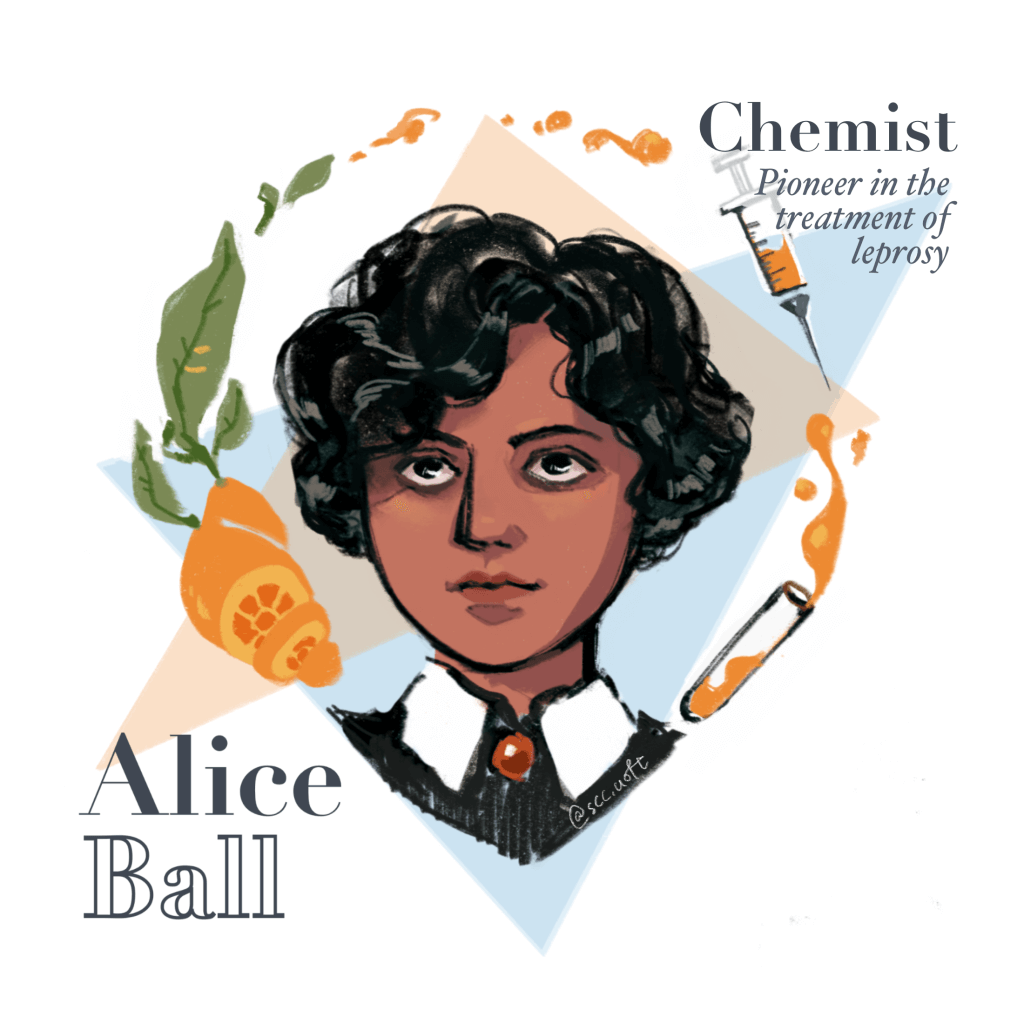
Written by Melissa Wong
Illustrated by Amy Zhang
February 29th was Alice Ball day, named for an exceptional African-American chemist. She is best known for a technique she developed in 1915 to treat leprosy, which is a bacterial infection that affects the skin and nervous system and can often lead to disfigurement. Alice was also the first female and African-American to obtain a master’s degree and to become a chemistry professor at the University of Hawaii.
Alice Ball was born into a middle-class family of photographers in Seattle. Her family’s role as photographers may have influenced her to study chemistry, as chemicals were used to develop photographs at the time. She studied at the University of Washington, where she graduated with two bachelors’ degrees in pharmaceutical chemistry and pharmacy science. During her time there, she was given the opportunity to publish an article in the well-respected Journal of the American Chemical Society, which was quite remarkablefor an African-American woman at the time!
Alice was only twenty-three years old when she discovered a treatment for leprosy. She identified a method to isolate and modify the active component of chaulmoogra oil, which originates from the seeds of the Hydnocarpus wightianus trees in India. The use of chaulmoogra oil to treat leprosy dates back to the thirteen hundreds, yet using the oil in its pure form was ineffective. This was because when the oil was applied topically, it quickly hardened, and when injected could cause blister formation. It could even induce vomiting if ingested!
Alice was approached by Dr. Harry Hollman from Kalihi Hospital in Hawaii and was asked to investigate the active component of chaulmoogra oil to treat leprosy. She had previous experience doing this type of work; her thesis for her Master’s degree was based on an investigation of the chemical properties of the Kava Root. Alice was able to formulate a water-soluble, injectable form of the chaulmoogra oil’s active component that didn’t cause the harmful side effects that resulted from the pure oil but still was able to cure leprosy. Alice’s technique is now known as the “Ball Method.”
Unfortunately, before she had time to publish her findings, Alice passed away from chlorine poisoning caused by a tragic lab accident. Her supervisor, Arthur Dean, took credit for her work, named the technique the “Dean Method,” and even began mass producing the injectable chaulmoogra oil. The success of the water-soluble chaulmoogra oil would later be reported in 1920 in the Journal of the American Association, and patients with leprosy from Kalihi Hospital and around the world began to be discharged for a disease that was once thought to be incurable.
It was not until 1922 when Dr. Hollman briefly recognized Alice Ball’s contribution to the development of the injectable chaulmoogra oil, which he termed the “Ball Method.” However, Alice remained largely unrecognized until the 1970s when a group of professors began looking into archives and found Alice’s work. When they realized Alice’s extensive efforts towards curing leprosy, her research was finally given proper credit.
Although Alice’s treatment of leprosy has been replaced by antibiotics, her discovery made a huge impact for individuals diagnosed with leprosy, especially since the disease has been heavily stigmatized throughout history. In the past, patients with leprosy were quarantined in “leper colonies” and confined to the Hawaiian island of Monokai where they remained until they died from the disease. However, some of their stories had a happy ending thanks to Alice’s research, which allowed them to return from isolation to their families.
Sources:
- https://en.wikipedia.org/wiki/Alice_Ball
- https://oumnh.ox.ac.uk/alice-ball
- https://uh.edu/engines/epi3205.htm
- https://www.sciencefriday.com/segments/alice-ball-leprosy/
- https://www.knkx.org/post/pioneering-black-female-chemist-seattle-mostly-unknown-here-s-why
- https://www.biography.com/scientist/alice-ball
- https://www.nationalgeographic.com/news/2018/02/alice-ball-leprosy-hansens-disease-hawaii-womens-history-science/
- https://scholarspace.manoa.hawaii.edu/handle/10125/1837
- https://www.publichealthontario.ca/en/diseases-and-conditions/infectious-diseases/respiratory-diseases/leprosy